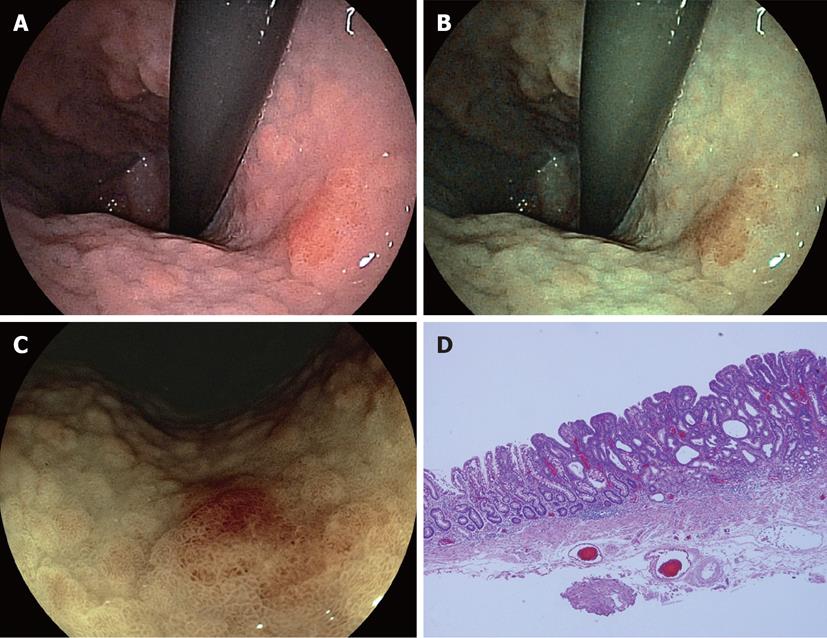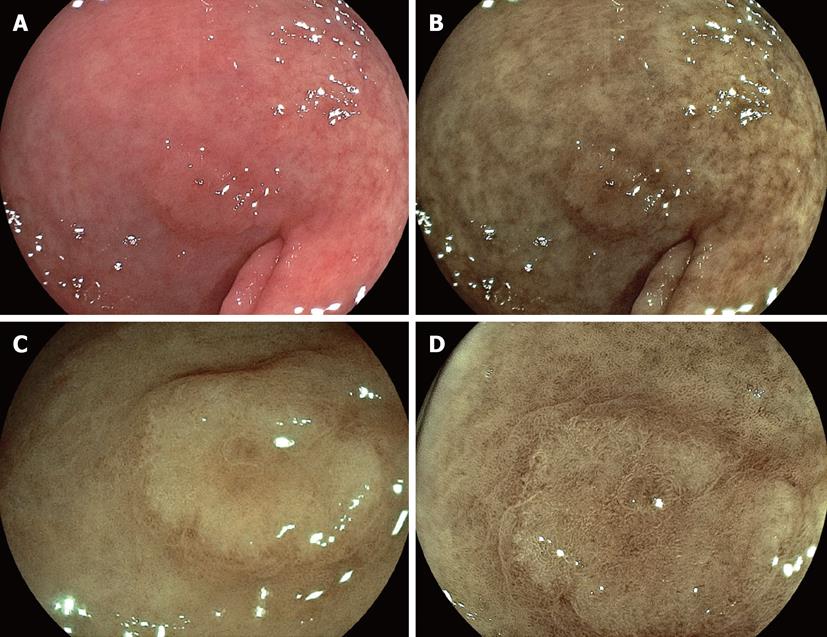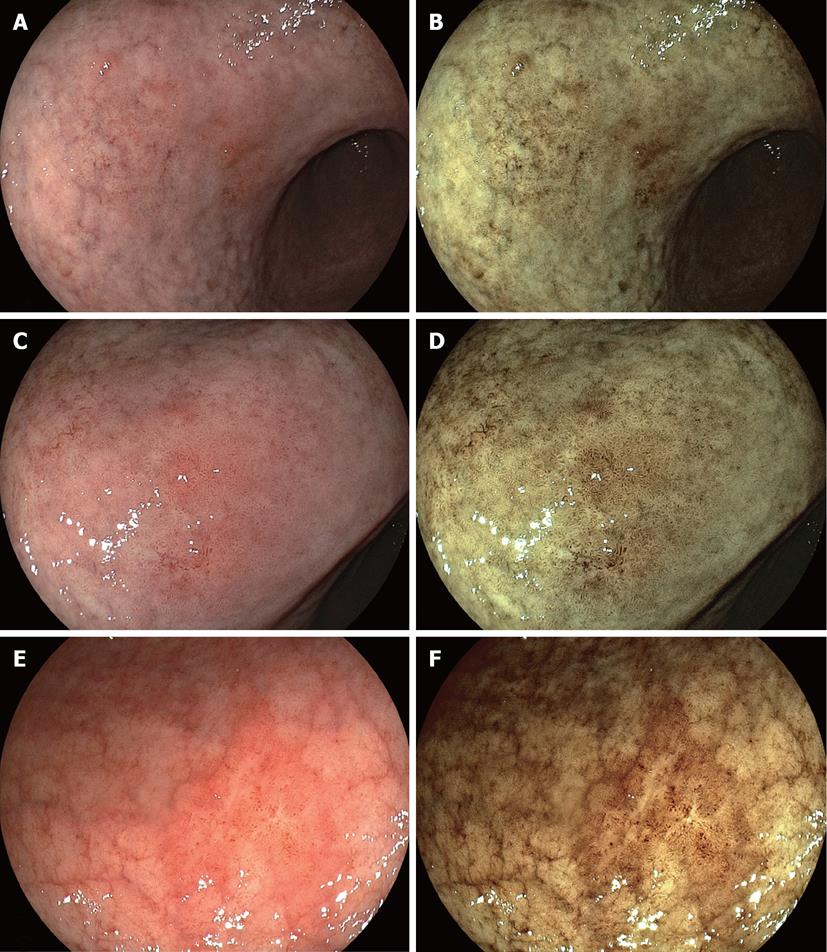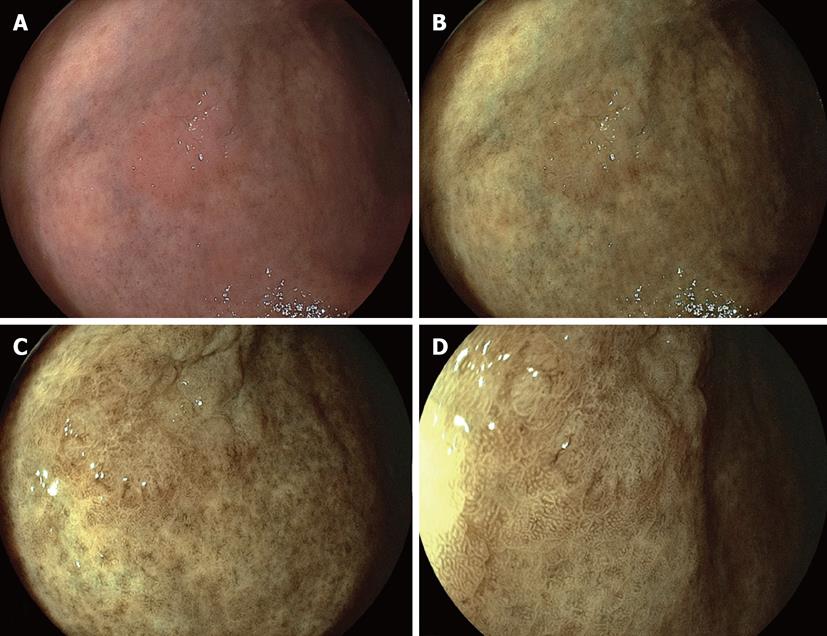Copyright
©2012 Baishideng.
World J Gastrointest Endosc. Aug 16, 2012; 4(8): 356-361
Published online Aug 16, 2012. doi: 10.4253/wjge.v4.i8.356
Published online Aug 16, 2012. doi: 10.4253/wjge.v4.i8.356
Figure 1 Image findings and specimen, A: Conventional image with small caliber endoscope (EG530-NW) reveals a slightly reddish mucosal change in the lesser curvature of the upper body; B: Flexible spectral imaging color enhancement (FICE) image with small caliber endoscope enhances a reddish cancerous lesion and can determine with precision a clear line of demarcation between cancer and the yellowish surrounding mucosa; C: FICE image with low magnification (EG590-ZW) also detects much clearer demarcation line; D: Specimen after endoscopic submucosal dissection shows a high density of glandular structure and an apparently irregular microvessel in intervening parts between crypts, which may cause a reddish mucosal change in depressed area.
Figure 2 Some depressed cancers are shown as whitish lesion by conventional endoscopy.
A: Conventional image (EG590-ZW) reveals a slightly whitish mucosal change in the anterior wall of antrum; B: Flexible spectral imaging color enhancement (FICE) image enhances a whitish cancerous lesion and can determine a line of demarcation between cancer and surrounding mucosa; C: FICE image in a close-up view (EG590-WR) detects with precision a clearer demarcation line; D: FICE image with half magnification (EG590-ZW) reveals a finer microstructural pattern on mucosal surface of cancer and higher contrasting mucosa between cancer and the surrounding area, leading a clearer demarcation line.
Figure 3 Conventional image and Flexible spectral imaging color enhancement image findings.
A: Conventional image (EG590-ZW) reveals a slightly enriched vascular structure of gastric mucosa in the lesser curvature of the lower body; B: Flexible spectral imaging color enhancement (FICE) image enhances such a structure and shows reddish lesions in its anal side near angle; C: Conventional image near angle in a close-up view shows slightly reddish changes on the flat mucosa; D: FICE image near angle in a close-up view shows an irregular structural pattern distinct from the surrounding area, leading to a clearer demarcation line; E: Conventional image (EG590-WR) reveals a slightly enriched vascular structure in nearly flat mucosa in the antrum in a close-up view; F: FICE image enhances such a structure accompanied by a clear margin of cancer distinct from the surrounding mucosa. It is noted that these images can be obtained without magnification.
Figure 4 Most elevated-type early gastric cancers are detected easily as yellowish lesions with clearly contrasting demarcation.
A: Conventional image (EG590-ZW) in a distant view reveals a slightly elevated lesion similar to the mucosal color of surrounding area in the anterior wall of lower body; B: Flexible spectral imaging color enhancement (FICE) image shows an uneven surface on the elevated tumor; C: A close-up FICE image without magnification exhibits an irregular microstructural pattern on uneven tumor surface distinct from the surrounding mucosa; D: FICE image with low magnification distinguishes an apparently irregular microstructural pattern of cancer from a normal microstructural pattern of the surrounding mucosa.
Figure 5 In some cases, a partially reddish change is accompanied on the tumor surface similar to depressed type cancer.
A: Conventional image (EG590-ZW) in a distant view reveals an elevated lesion with slightly reddish portion in the posterior wall of antrum; B: Flexible spectral imaging color enhancement image enhances a reddish portion on tumor surface with more contrasting demarcation line. In addition, tumor margin of flat area in the right side of this figure can be more clearly visualized than conventional image.
Figure 6 The irregular microvascular pattern of lesions is clearly visualized with half magnification.
A: Conventional image (EG590-ZW) in a close-up view reveals a nearly flat lesion with a slightly reddish portion in the anterior wall of middle body; B: Flexible spectral imaging color enhancement (FICE) image enhances a reddish lesion leading to a clear demarcation line; C: Conventional image with half magnification shows an enriched microvascular structure on the tumor surface; D: FICE image with half magnification allows a clear visualization of irregular microvascular and microstructural pattern suggesting gastric cancer with the possible histological type of well-differentiated adenocarcinoma.
- Citation: Osawa H, Yamamoto H, Miura Y, Yoshizawa M, Sunada K, Satoh K, Sugano K. Diagnosis of extent of early gastric cancer using flexible spectral imaging color enhancement. World J Gastrointest Endosc 2012; 4(8): 356-361
- URL: https://www.wjgnet.com/1948-5190/full/v4/i8/356.htm
- DOI: https://dx.doi.org/10.4253/wjge.v4.i8.356














